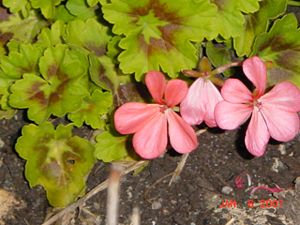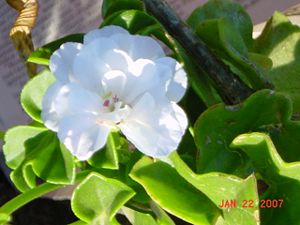Pelargonium: Difference between revisions
imported>Aleta Curry (+photo, just for MBE) |
imported>Aleta Curry (format & expand on flower pattern + photos) |
||
| Line 1: | Line 1: | ||
{{subpages}} | {{subpages}} | ||
[[Image:Pelargonium hortortum - zonal geranium.JPG|right|thumb|300px|{{#ifexist:Template:Pelargonium hortortum - zonal geranium.JPG/credit|{{Pelargonium hortortum - zonal geranium.JPG/credit}}<br/>|}}A common variety of zonal pelargonium.]] | |||
'''Pelargoniums''' are bushy shrubs in the geraniaceae family, originating from Southern Africa. They are commonly called [[geranium]]s, because that is how they were originally classified, since Europeans noticed their similarity to true (botanical) geraniums, (which are now classed is a different [[genus]]), and called them ''South African Geraniums''. True geraniums are sometimes called ''Cranesbills'' to help distinguish them from pelargoniums. | '''Pelargoniums''' are bushy shrubs in the geraniaceae family, originating from Southern Africa. They are commonly called [[geranium]]s, because that is how they were originally classified, since Europeans noticed their similarity to true (botanical) geraniums, (which are now classed is a different [[genus]]), and called them ''South African Geraniums''. True geraniums are sometimes called ''Cranesbills'' to help distinguish them from pelargoniums. | ||
[[Image: | [[Image:White ivy geranium flower - pelargonium peltatum.JPG|left|thumb|300px|{{#ifexist:Template:White ivy geranium flower - pelargonium peltatum.JPG/credit|{{White ivy geranium flower - pelargonium peltatum.JPG/credit}}<br/>|}}This plant is commonly known as Ivy Geranium, Ivy-leaved (also Ivy Leaf) Geranium or Ivy-leaved Pelargonium.]] | ||
Pelargoniums are best distinguished from botanical geraniums by the shape of their flowers: they have two petals on top of the flower and three on the bottom, although in fancier varieties this pattern can be hard to discern. They can be roughly divided into four categories: Regal (Martha Washington), Zonal (so called because a coloured band divides the leaf into different "zones", ivy-leaved (because its leaves and climbing/traling habit resembles that of [[ivy]] & scented-leaf pelargoniums. Most of the species in these categories are [[hybrid]]s. The Regal Pelargonium and the Zonal Pelargonium are among the most commonly grown. | Pelargoniums are best distinguished from botanical geraniums by the shape of their flowers: they usually have two petals on top of the flower and three on the bottom, although in fancier varieties (with compounded petals or more than one layer of petals) this pattern can be hard to discern. They can be roughly divided into four categories: Regal (Martha Washington), Zonal (so called because a coloured band divides the leaf into different "zones", ivy-leaved (because its leaves and climbing/traling habit resembles that of [[ivy]] or ''[[hedera]]'') & scented-leaf pelargoniums. Most of the species in these categories are [[hybrid]]s. The Regal Pelargonium and the Zonal Pelargonium are among the most commonly grown. | ||
Pelargoniums are hardy, drought-tolerant and easily-propagated from stem cuttings, so they’re an easy plant for the novice to grow. Many are evergreen and flower throughout the year, and this adds to their popularity. Some can tolerate the occasional frost, but in general pelargonims are not frost-hardy and in cold climates must be brought indoors or treated as [[annual plant|annuals]]. | Pelargoniums are hardy, drought-tolerant and easily-propagated from stem cuttings, so they’re an easy plant for the novice to grow. Many are evergreen and flower throughout the year, and this adds to their popularity. Some can tolerate the occasional frost, but in general pelargonims are not frost-hardy and in cold climates must be brought indoors or treated as [[annual plant|annuals]]. | ||
Revision as of 20:42, 12 November 2007
Pelargoniums are bushy shrubs in the geraniaceae family, originating from Southern Africa. They are commonly called geraniums, because that is how they were originally classified, since Europeans noticed their similarity to true (botanical) geraniums, (which are now classed is a different genus), and called them South African Geraniums. True geraniums are sometimes called Cranesbills to help distinguish them from pelargoniums.
Pelargoniums are best distinguished from botanical geraniums by the shape of their flowers: they usually have two petals on top of the flower and three on the bottom, although in fancier varieties (with compounded petals or more than one layer of petals) this pattern can be hard to discern. They can be roughly divided into four categories: Regal (Martha Washington), Zonal (so called because a coloured band divides the leaf into different "zones", ivy-leaved (because its leaves and climbing/traling habit resembles that of ivy or hedera) & scented-leaf pelargoniums. Most of the species in these categories are hybrids. The Regal Pelargonium and the Zonal Pelargonium are among the most commonly grown.
Pelargoniums are hardy, drought-tolerant and easily-propagated from stem cuttings, so they’re an easy plant for the novice to grow. Many are evergreen and flower throughout the year, and this adds to their popularity. Some can tolerate the occasional frost, but in general pelargonims are not frost-hardy and in cold climates must be brought indoors or treated as annuals.

